Beginner Strongman Program: Your Ultimate Guide
Author:
Reviewed by:
(21 years of Oly Lifting experience)
Unlock your full potential by engaging with our experts and community! Have questions about your fitness journey or looking for expert advice on weightlifting techniques? Don’t hesitate — leave a comment below and Sergiy Osipchyk will provide a personalized answer and insights to help you reach your goals.
Torokhtiy is reader-supported. Some links are affiliate links, and we may earn a commission at no extra cost to you. See our disclosure page for details.
If you’re looking to build some serious strength and power, look no further than a strongman program. If you’re also new to this, then the beginner program is the perfect place to start because. It’s important to note that this regimen is not just for the elite; anyone can use it to get stronger, fitter, and more confident.
This guide will be like your guide as it walks you through the basics, and provides step-by-step explanations on how to get the most out of this program. And, of course, we have some expert tips and techniques to share with you.
Ready to get stronger? Let’s see how to start strongman training!
What is the beginner strongman program? – It’s a structured training plan made for beginners to strongman lifting. It focuses on traditional exercises (squats, bench presses, deadlifts, farmer’s walks, etc.) and alternate movements such as tire flips to build strength, endurance, and functional fitness.
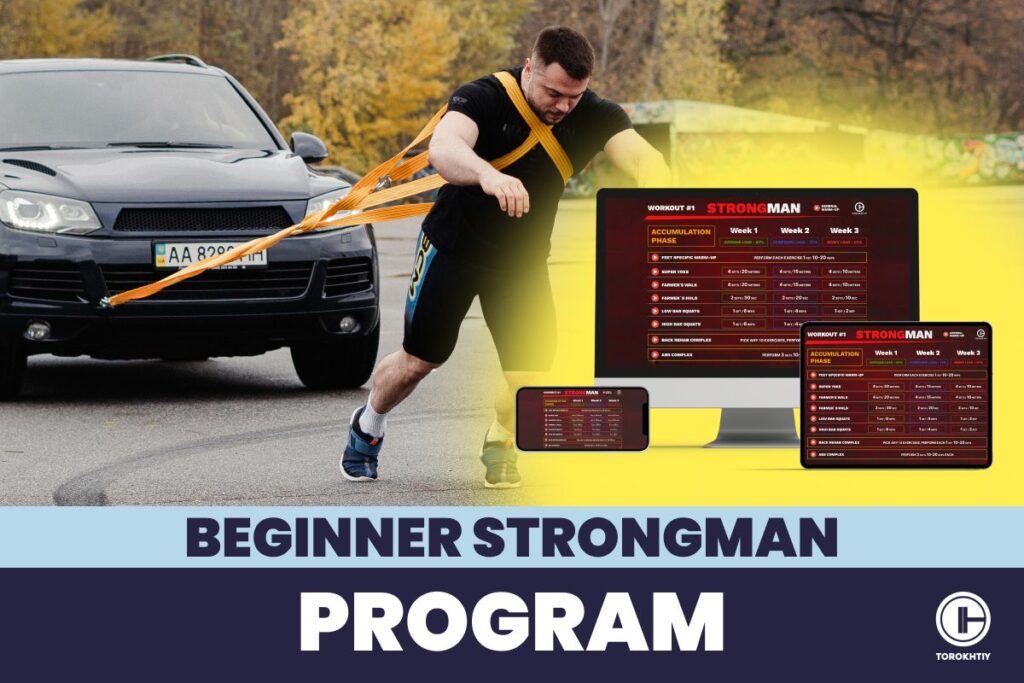
Starter Program
As the name would suggest, this is a program that’s primarily meant for beginners in strength training. However, even if you’re an athlete and you want to switch up your routine, you could benefit from the beginner strongman program.
This is really inclusive so there’s not a lot of people that should avoid it. It will build a solid foundation, increase your strength and endurance gradually, and allow you to progress.
The Main Goal Development of Exercise Technique
The main goal is to develop proper exercise technique. This means, you’ll learn the correct way to do each movement, which will prevent injuries and make sure you’re working the right muscles. You’ll need to understand the general tasks of each exercise, like lifting or carrying.
Adapting to different loads or weights is also an important part of the program. As you get stronger, you’ll increase the weight gradually to keep challenging yourself – this is the foundation of progress.
You’ll start with lighter weights because safety should always be your priority. This program is suitable for pretty much everyone with a basic fitness level, but you still need to assess your physical condition and mental state and be honest about it. Don’t overestimate yourself because that will land you in a pickle.
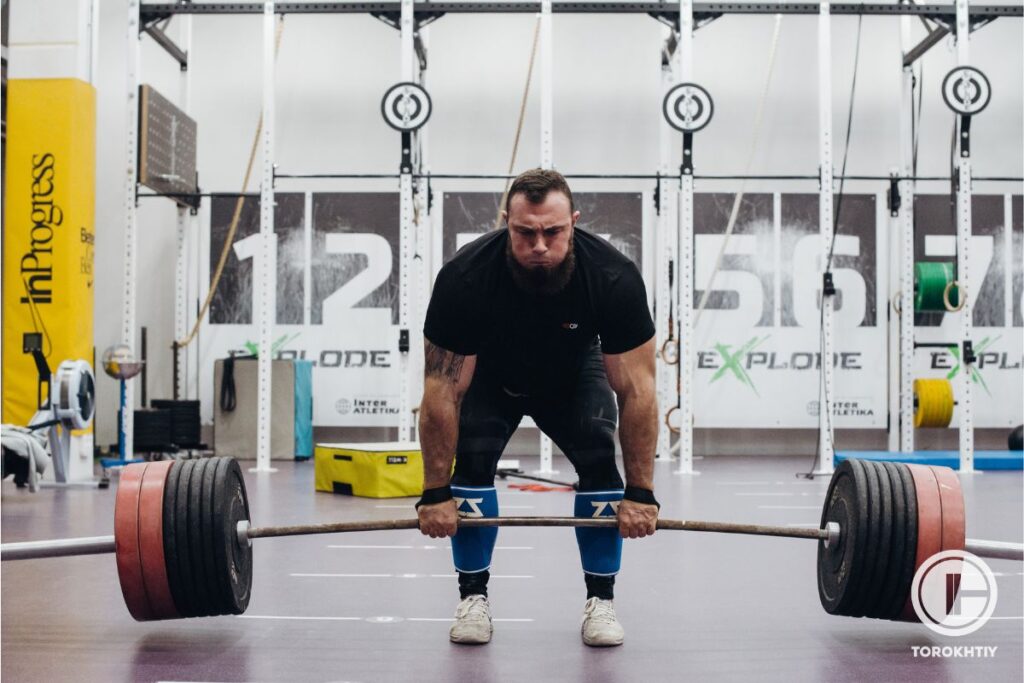
If there are any health limitations or physical injuries, take them into account and speak with your doctor before you start.
Previous sports experience is a plus, but keep in mind that strongman exercises are unique, so learning them correctly takes time and practice.
Save it for easy access!
Bookmark this page now to access the program and instructional videos anytime, anywhere.
Stop wasting time searching during your gym sessions.
Educational and Developing Period
This is a structured period in which you’ll learn the basics, develop strength, and get used to the challenges of beginner strongman training. It’s how you build a solid foundation because without it, there’s no going forward.
1. Microcycle – 3 Training Sessions per Week
A microcycle is usually made up of 3 training sessions per week. They focus on different aspects of strength and technique and they will allow you to adapt to these new challenges. Each session will have specific exercises to target different muscle groups, and the reason for that is to make sure you get a balanced development and enough down time, which is very important.
2. Mesocycle – 8 Weeks
This part spans over 8 weeks and its purpose is to increase your strength and endurance little by little. During the course of these 8 weeks, you’ll notice improvements in your technique and performance, which is ideal for motivation. You’ll be able to set short-term goals, track progress, and all of this will keep you on the right path.
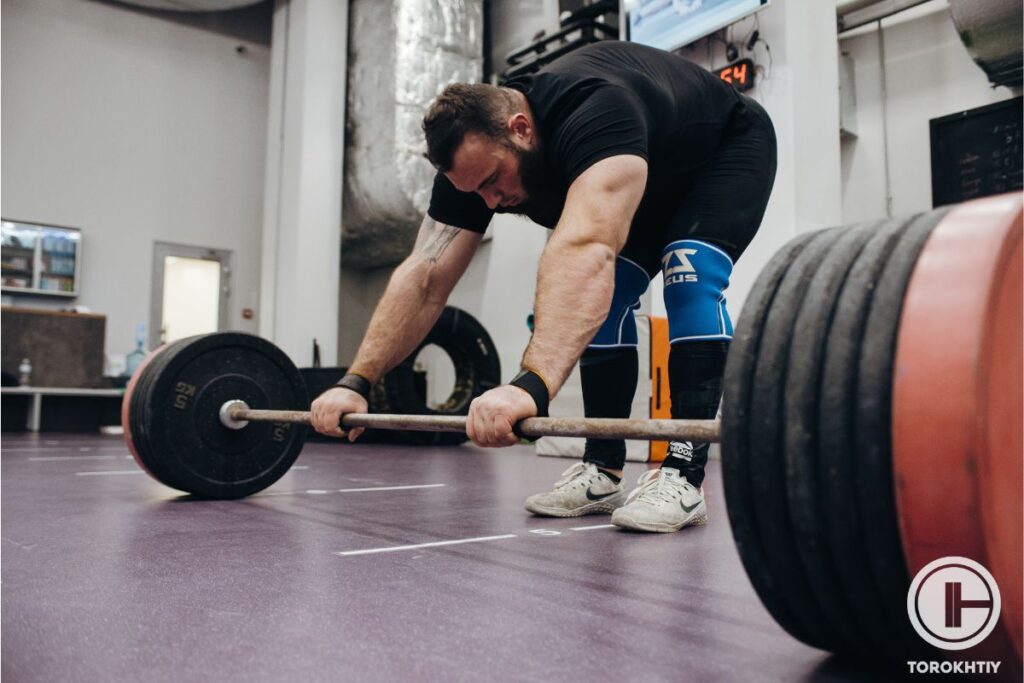
3. The Progression Is Linear
Linear progression means you’ll increase the intensity of your workouts at a steady pace. You’ll start with lighter weights and simple exercises and slowly move on to the butt-kicking ones. This way, you build confidence and you let your body adapt without unnecessary strain.
4. Intensity – Percentage of Max
Basically, this means that a percentage of your lifting capacity determines how difficult your exercises are. It prevents overtraining, builds your strength in a safe way, and makes it possible to push your limits without risking injury.
Follow us!

Free!
Get a 2-week Weightlifting Program as a bonus for the subscription to kickstart your training plan!

Free!
Training Schedule
If you want to get ahead and see some actual progress, you’ll need a plan. This is a schedule that’s divided into 3 main parts, and each of them concentrates on different aspects of your development so your strongman training program for beginners is balanced.
Part 1: Preparatory (Articular Muscle)
The first part preps you for what comes next and focuses on articular muscle exercises. The purpose of these exercises is to warm up your joints and muscles and get you ready for what follows. Expect mobility drills, dynamic stretches, and light exercises to activate key muscle groups.
Warm-ups are important, so this part plays a bigger role than you think.
Part 2: Developing (Technique of Power Types)
Time to get seriously busy! The developing part is all about mastering the techniques and various power types.
1. Strongman
You’ll do specific exercises like tire flips, farmer’s walks, and log lifts. These mimic the events you’ll find in competitions and they’ll do wonders for your functional strength and endurance.
2. Weightlifting
Next on the schedule – Olympic lifting, specifically the snatch and the clean and jerk. They’re excellent for working on your explosive power and just strength in general, and they can help you perform better in strongman events.
3. Powerlifting
Here, the focus is on the squat, bench press, and deadlift. These are basic lifts that you’re likely familiar with. They’re the backbone of your strength training.
4. Bodybuilding
You need bodybuilding to enhance muscle hypertrophy and balance. You can expect different isolation exercises to target specific muscles so that all areas of your body are strong and well-developed.
Part 3: Restorative (Rehab Stretching)
You’ve made it to the last part so the first thing to do – congratulate yourself on a job well done!
After you’ve patted yourself on the back, you’ll do some stretches, some foam rolling… The point of this part is to prevent injuries and support recovery. It will get you ready for the next training session, reduce soreness in your muscles, and maintain flexibility.
Basic Beginner Strongman Program
Now that you’ve got the general idea of how this looks, we’ll share some specifics on strongman training for beginners.
| Day | Exercise | Sets/Reps |
|---|---|---|
| Day 1 | Warm-Up | 10-15 min |
| Squat | 3×5 reps | |
| Bench Press | 3×5 reps | |
| Deadlift | 3×5 reps | |
| Core Exercises: Plank | 3×30 sec | |
| Cool-Down | 10-15 min | |
| Day 2 | Warm-Up | 10-15 min |
| Overhead Press | 3×4 reps | |
| Tire Flip | 3×4 reps | |
| Kettlebell Swings | 3×6 reps | |
| Core Exercises: Hanging Leg Raise | 3×10-15 reps | |
| Cool-Down | 10-15 min | |
| Day 3 | Warm-Up | 10-15 min |
| Yoke Walk | 3×20 m | |
| Farmer’s Walk | 3×20 m | |
| Sandbag Carry | 3×20 m | |
| Cool-Down | 10-15 min |
Day 1: Maximal Strength Development
Remember that correct form is key! If you struggle with it, think about working with a coach or using video analysis to see what needs to be worked on.
1. Warm-Up
Start your beginner strongman workout with 10-15 minutes of dynamic stretches and mobility exercises. Focus on your hips, shoulders, and lower back so your joints are ready for heavy lifting.
2. Squat
You’ll do 3 sets of 5 reps. Make sure to get the full depth, keep your back straight and engage your core throughout the lift. As far as the weight goes, it should be challenging, but not so much that it makes you mess up the form.
3. Bench Press
3 sets of 5 reps again! Keep your feet flat on the ground, back a little bit arched, and lower the bar to your chest in a controlled way. Tweak the weight if you need to, you should be able to do all reps with good form.
4. Deadlift
Pay attention to lifting with your legs, keeping your back straight, and engaging your core. Do 3 sets of 5 reps with a weight that challenges you.
5. Core Exercises: Plank
Hold the plank for 3 sets of 30 seconds. Engaging your core is a given, but apart from that, you also need to keep your body in a straight line from head to heels and you should avoid letting your hips sag or rise.
6. Cool-Down
You’ll finish the first day with 10-15 minutes of static stretches and you’ll focus on the major muscle groups. You can do hamstring stretches, chest stretches, and lower back stretches. It’s easy to get lazy and skip the cool-down – after all, you’ve just worked your butt off. But cool-down is important because it helps with flexibility and recovery.
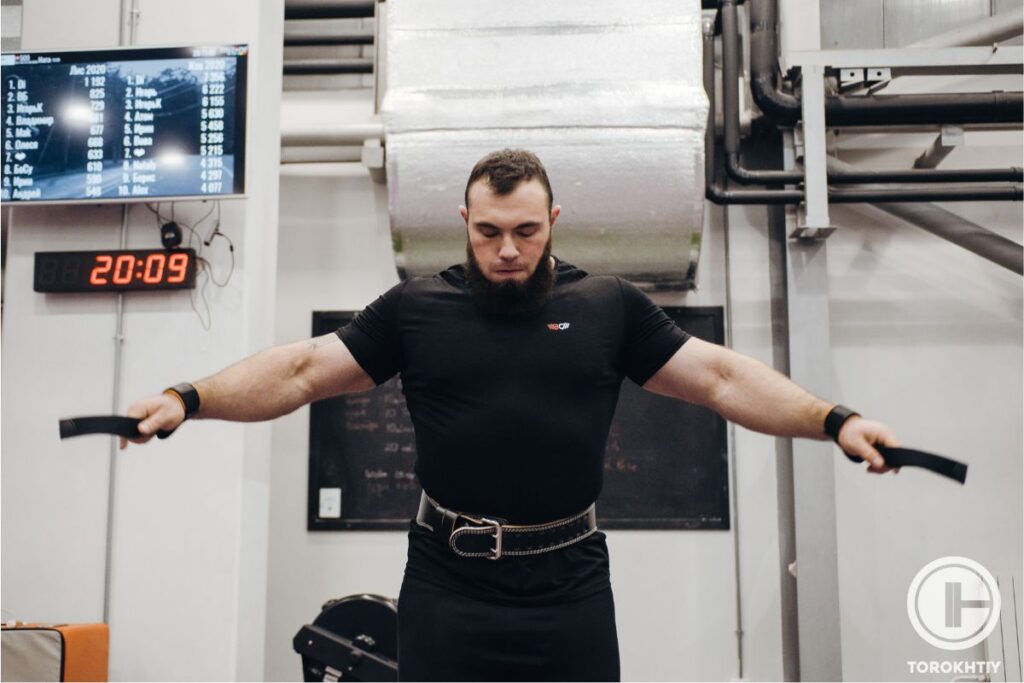
Day 2: Explosive Strength Development
The second day keeps things explosive, and explosive strength needs a lot of precision to avoid injuries and maximize power output.
1. Warm-Up
No surprises here – 10-15 minutes of dynamic stretches and mobility drills to loosen up your shoulders, hips, and lower body.
2. Overhead Press
Do 3 sets of 4 reps and make sure to drive the weight explosively from your shoulders. Engage your core and keep a stable stance.
3. Tire Flip
3 sets of 4 reps, during which you’ll use your entire body to lift and flip the tire. Focus on a powerful drive from your legs and keep remember to keep your back straight.
4. Kettlebell Swings
You’ll swing the kettlebell using your hips. Keep your arms relaxed because the power should come from your lower body. The swing needs to be explosive, of course, because that’s how we like to keep things on the second day.
3 sets of 6 reps for these.
5. Core Exercises: Hanging Leg Raise
You didn’t think we forgot about the core, did you? Do 3 sets of 10-15 reps of hanging leg raises – keep it controlled, engage your core completely, and don’t swing your body.
6. Cool-Down
End with 10-15 minutes of shoulder stretches, hip flexor stretches, and hamstring stretches to help your muscles recover and promote flexibility.
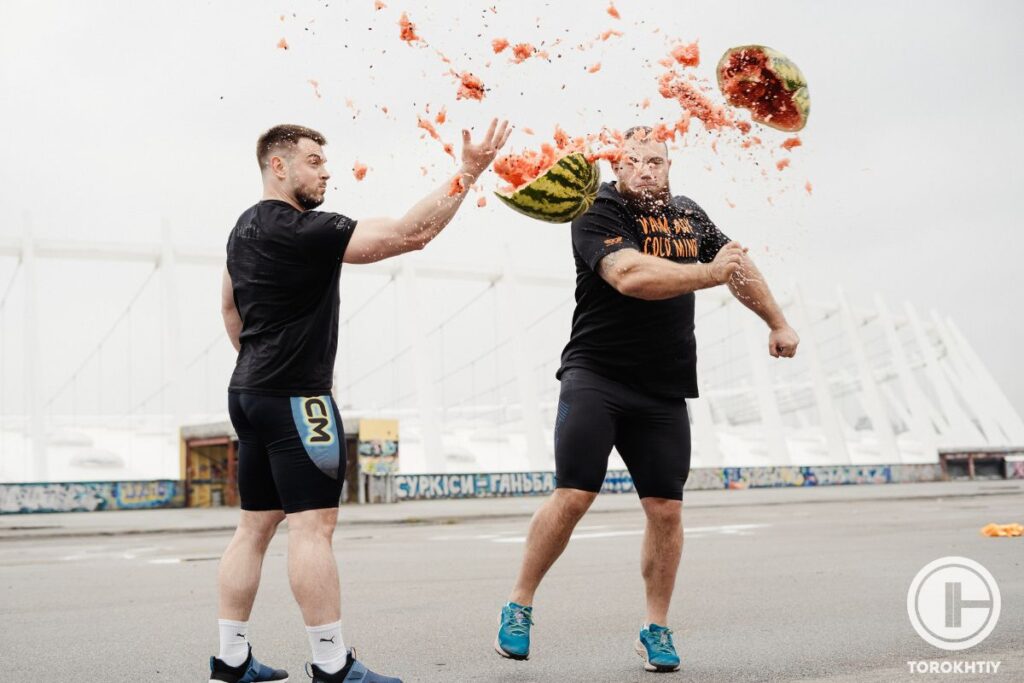
Day 3: Functional Strength, Endurance, and Cardio
The exercises you’ll do on the third day rely heavily on stability and balance, so your form is super important. Keep things controlled, don’t rush, and have fun!
1. Warm-Up
10-15 minutes of dynamic stretches and mobility exercises to get you ready for the main part!
2. Yoke Walk
Starting off with the yoke walk, you’ll do 3 sets of 20 meters. Steady pace, good posture, balanced weight, and you’re golden! Focus on core stability and controlled breathing.
3. Farmer’s Walk
The yoke walk is followed by a farmer’s walk – 3 sets of 20 meters this time around, too. Grip the weights firmly, keep your shoulders back, and walk with stability.
4. Sandbag Carry
Next on the schedule, we have the sandbag carry. 3 sets of 20 meters again! Hold the sandbag securely against your body, keep your posture strong, and move at a steady pace.
5. Cool-Down
End the third day with 10-15 minutes of calf stretches, quad stretches, and upper back stretches.
Conclusion
Look at this as the first step towards building strength, power, and endurance that’s impressive to say the least. You might mistake this for just lifting heavy weights, but that’s not the point at all – you want to master the techniques and challenge yourself.
Your best friends are consistency and form. This is an intense program, so each small improvement is a cause for celebration. If you stay dedicated, you’ll watch your strength skyrocket.
What’s your first strongman goal? How will you include these exercises into your current routine? What long-term goals are you setting for yourself?
Leave a comment because we want to hear everything – random thoughts, concerns, constructive criticism… Whatever you feel like sharing, we’re here for it!
Stay strong (and persistent)!
References:
- Becks Shepherd “Why are rest days important?” LiveScience, https://www.livescience.com/why-are-rest-days-important (accessed July 3rd, 2024)
- Daniel Plotkin, Max Coleman, Derrick Van Every, Jaime Maldonado, Douglas Oberlin, Michael Israetel, Jared Feather, Andrew Alto, Andrew D. Vigotsky, Brad J. Schoenfeld “Progressive Overload Without Progressing Load? The Effects of Load or Repetition Progression on Muscular Adaptations,” PeerJ 10 (2022): e14142
- Health Promotion Board (HPB) “Prevent Injuries with Proper Form During Workouts,” Singapore University Health Center, https://www.nus.edu.sg/uhc/articles/details/prevent-injuries-with-proper-form-during-workouts (accessed July 3rd 2024)
- Hyoung-Kil Park, Min-Kyung Jung, Eunkyung Park, Chang-Young Lee, Yong-Seok Jee, Denny Eun, Jun-Youl Cha, and Jaehyun Yoo. “The effect of warm-ups with stretching on the isokinetic moments of collegiate men.” Journal of Exercise Rehabilitation 14, no. 1 (2018): 78–82.
- Mayo Clinic Staff, “Weight training: Do’s and don’ts of proper technique,” Mayo Clinic, https://www.mayoclinic.org/healthy-lifestyle/fitness/in-depth/weight-training/art-20045842 (accessed July 3rd, 2024)
- Photos by Torokhtiy Media Team.
Why Trust Us?
With over 20 years in Olympic weightlifting, strength training, nutrition coaching, and general fitness our team does its best to provide the audience with ultimate support and meet the needs and requirements of advanced athletes and professional lifters, as well as people who strive to open new opportunities and develop their physical capabilities with us.
By trusting the recommendations of our certified experts in coaching, nutrition, and sports training programming, as well as scientific consultants, and physiotherapists, we provide you with thorough, well-considered, and scientifically proven content. All the information given in the articles concerning workout programming, separate exercises, and athletic performance, in general, is based on verified data.
The product testing process is described in more detail here.
Author: Sergiy Osipchyk
Strongman Coach,
Former coach of Oleksiy Novikov and Pavlo Nakonechnyy
Strongman Experience: 10+ years
Sergiy has been involved in strength sports since he was 10 years old, and already started coaching when he was just 15 years old.
He helps clients of any age and experiences achieve results using an individual approach, daily process control, consultation and training knowledge and techniques, total experience is more than 20,000 individual training sessions.
Sergiy has trained a roster of renowned PRO strongman athletes including Oleksii Novikov, Pavlo Nakonechnyy and many other.
Reviewed by: Oleksiy Torokhtiy
Olympic Weightlifting Champion, PhD in Sport Science
Best Results: Snatch – 200 kg,
C&J – 240 kg
Oleksiy Torokhtiy is a professional athlete boasting 20 years of experience in Olympic weightlifting. With multiple European and World titles under his belt, he has showcased his prowess in two Olympic Games (Beijing 2008 and London 2012). Upon concluding his illustrious career, Oleksiy dedicated himself to coaching. By 2022, he had conducted over 200 weightlifting seminars worldwide. He is the visionary behind an international sportswear and accessories brand known for its motto, “Warm Body Cold Mind.” Additionally, he is an esteemed author and the creator of a series of training programs and eBooks.




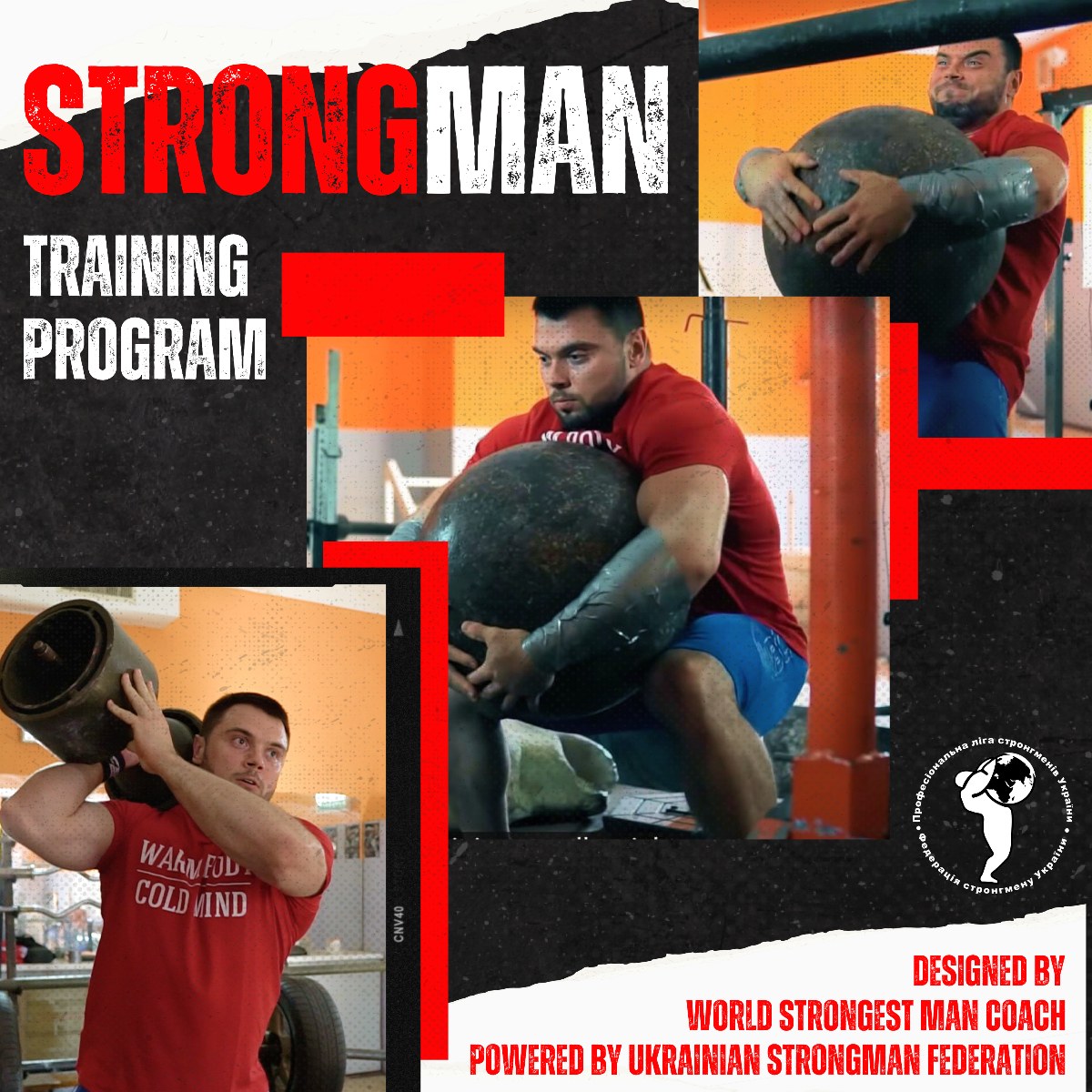
Still have questions after reading our article? Unlock your full potential by engaging with our experts and community! Don’t hesitate — leave a comment below and Sergiy Osipchyk will provide a personalized answer and insights to help you reach your goals.